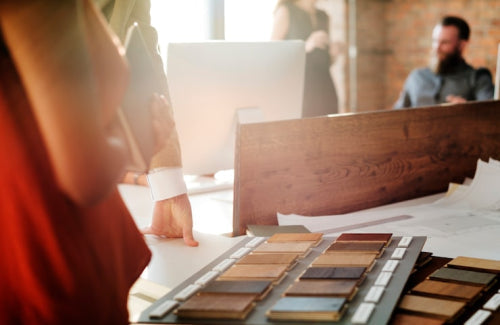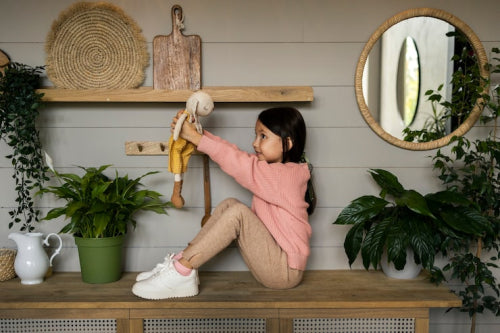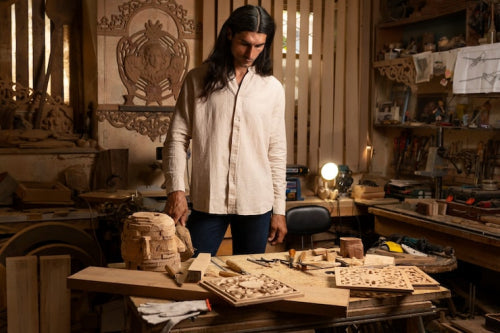Quick Listen:
The pulse of interior design beats strongest in the realm of the bespoke. No longer content with cookie-cutter furnishings, homeowners and businesses alike demand pieces that whisper their stories through grain and curve. Bespoke wood furniture, with its tactile warmth and infinite adaptability, has ascended from niche luxury to indispensable tool in the designer's arsenal. This surge reflects a broader cultural pivot: in an era of mass production, individuality reigns supreme. The global bespoke furniture market, valued at $30 billion in 2023, now hurtles toward $60 billion by 2032 at a 7.5% CAGR, fueled by escalating disposable incomes and a fervor for high-quality, tailored home and office solutions. At the vanguard stands MMC Wood Creations, whose mastery in custom woodcraft empowers designers to forge environments that resonate deeply, blending functionality with profound personal expression.
Mass-market furniture lacks heart, filling rooms with bland, short-lived pieces. Frequent breakdowns spark frustration, as replacements erode style and sentiment. At MMC Wood Creations, Udaipur artisans shape heirloom furniture with enduring craftsmanship and cozy elegance, creating pieces that echo your identity, ensuring your home radiates warmth and timeless connection. Shop Now!
Emerging Trends in Bespoke Wood Design
Sustainability emerges as the ethical backbone of this renaissance. With environmental stewardship now non-negotiable, designers champion woods harvested responsibly, from reclaimed oaks to FSC-certified exotics. This ethos not only honors the planet but also imparts an authentic patina to each creation, appealing to eco-savvy clients who view their homes as extensions of planetary care. The custom furniture market, pegged at $35.45 billion in 2025, eyes $65.67 billion by 2032 with a brisk 9.2% CAGR, where wood claims 39.5% of material shares by year's end, underscoring its enduring allure amid green imperatives.
Yet, the true ingenuity lies in marrying modernism with time-honored craft. Picture lithe, minimalist lines etched into heirloom hardwoods, yielding ergonomic marvels that multitask effortlessly a console that conceals cables, a bench that unfolds into a desk. This hybrid vigor caters to urban dwellers craving versatility without sacrificing soul. Sofas and couches, poised to snag 33.9% market in 2025, exemplify this fusion, their wooden frames sheathed in fabrics that nod to both innovation and inheritance. Residential realms, commanding 51% dominance, serve as prime testing grounds, where such integrations prove that bespoke wood isn't just furniture it's the architecture of adaptable living.
Real-World Applications of Bespoke Wood Pieces in Interior Design
In the intimate theater of homes, bespoke wood performs its most poignant roles. Envision a living room anchored by a low-slung walnut credenza, its drawers dovetailed to cradle heirlooms while its surface hosts impromptu family councils. Bedrooms yield to nightstands hewn from sycamore, their subtle inlays echoing the room's serene palette, fostering rest amid bespoke tranquility. Kitchens, those hearts of domesticity, brim with islands of butcher-block maple, scarred just enough to invite chopping yet polished to gleam under pendant lights. These interventions don't merely decorate; they amplify aesthetics and utility, turning square footage into symphony. The residential sector's 51% stronghold in custom furnishings by 2025 attests to this, as families invest in pieces that grow with them, from nursery cribs evolving into dressers.
Commercial landscapes, too, bow to bespoke's transformative touch. Offices deploy conference tables of burled elm, their expansive tops etched with laser-precise motifs that brand every boardroom huddle. Hotels lure guests with lobby vanities of teak, veined like marble yet warmer to the touch, infusing transience with permanence. Restaurants craft bar fronts from charred shou sugi ban pine, their smoky allure drawing patrons into narratives of fire and feast. Consider a recent hospitality overhaul: a coastal inn where custom wood paneling ripped from driftwood analogs mirrored the sea's rhythm, burnishing the brand's eco-narrative. This aligns with the wooden furniture market's trajectory, ballooning from $461.84 billion in 2024 to $719.61 billion by 2032 at 5.70% CAGR, propelled by demands for durable, eco-tuned customizations that imprint identity indelibly.
Such triumphs stem from symbiotic collaborations. Designers, armed with sketches and swatches, partner with virtuosos like MMC Wood Creations to transmute concepts into corporeality. Iterative prototypes sanded, stained, scrutinized ensure fidelity to vision, from load-bearing specs to aesthetic whispers. Architects join the fray, specifying joins that withstand seismic shifts while evoking organic flow. This triad forges not just objects but ecosystems, where wood becomes the narrative thread binding disparate elements into cohesive wholes.
Key Challenges in Incorporating Bespoke Wood Pieces
For all its allure, bespoke wood demands rigorous navigation of pitfalls. Foremost among them: the twin specters of cost and chronology. High-caliber customry exacts premiums for artisanal hands and rare grains think quartersawn white oak, its scarcity inflating bills while global logistics snag timelines. Sourcing exotics like zebrawood might span months, testing budgets stretched by unforeseen tariffs or harvests delayed by monsoons. Designers, ever the strategists, mitigate by prioritizing heirloom woods over novelties, yet the premium often double mass-market tags requires client buy-in, framed as investment in legacy.
Equally vexing is harmonizing bespoke with holistic schemes. A rogue sculpture of ebony might dazzle in isolation but clash amid mid-century moderns, demanding deft calibration of tones and scales. Designers enforce alignment through mood boards digitized for virtual walkthroughs, ensuring each piece dialogues with its chorus. Practicality tempers extravagance: a flamboyant armoire must yield to ergonomic access, lest beauty betray utility. These tensions, though taxing, hone precision, compelling creators to balance bespoke's wild heart with design's disciplined mind.
Opportunities, Efficiencies, and Business Impacts
Bespoke wood unlocks vaults of potential, chief among them the alchemy of identity. For clients, it's bespoke billboards pieces that encapsulate tastes, from a CEO's monolithic desk evoking corporate fortitude to a café's trestle tables fostering communal spark. Businesses harvest loyalty through such tailoring, as personalized solutions cement alliances, turning one-off gigs into enduring patronage. In branding, wood's versatility shines: a law firm's walnut wainscoting signals gravitas, while a startup's reclaimed pallet partitions pulse with innovation.
Valuation surges follow suit. Spaces adorned with custom wood command premiums think 15-20% uplifts in resale for homes boasting integrated millwork, their uniqueness a magnet in saturated markets. Projects stand taller in portfolios, bespoke flourishes differentiating amid homogenization. Efficiency, too, accrues: multifunctional designs like beds with hydraulic lifts concealing linens optimize footprints in cramped cosmopolises. Partnering with attuned craftsmen slashes revisions; MMC Wood Creations, versed in designer dialects, delivers prototypes that intuit needs, conserving hours once lost to mismatches. Digital adjuncts amplify this: 3D platforms let clients virtually inhabit choices, streamlining from concept to install and burnishing satisfaction.
Broader ripples touch commerce: the customization tide spurs agile manufacturing, where modular lines flex to whims, fostering loyalty via interactivity. Direct-to-consumer portals, previewing finishes in augmented reality, democratize design, empowering even modest budgets to bespoke bliss. Thus, bespoke wood doesn't just furnish it fortifies ecosystems of value, where every grain gleans profit and purpose.
Expert Insights and Future Outlooks
Design luminaries affirm bespoke wood's pivotal perch. As one observer notes, 2025 heralds authenticity's triumph eschewing builder-grade banalities for lived-in luxury that marries vintage patina with modern ease. Quiet opulence thrives in hand-carved reliefs and textured weaves, while personalization layers heirlooms into tapestries of heritage, from thrifted relics reupholstered in bespoke fabrics to ornate woods evoking bygone eras. These voices underscore wood's role as storyteller, crafting havens that soothe and inspire.
Gazing forward, bespoke wood's horizon dazzles with hybrid horizons. Smart infusions sensors humming in tabletops, adjusting hues to circadian cues beckon, as do composites blending wood with bio-resins for featherweight fortitude. Vintage revivals will deepen, retro accents layered with sustainable twists, ensuring endurance amid flux. MMC Wood Creations, trailblazing with these fusions, positions as linchpin, their innovations ensuring bespoke remains not relic, but revolution. In September 2025's light, as markets swell and tastes refine, one truth endures: bespoke wood shapes not just spaces, but souls timeless testaments to craft's quiet command.
Frequently Asked Questions
How much does custom wood furniture cost compared to mass-produced pieces?
Custom wood furniture typically costs about double the price of mass-market alternatives due to the premium materials, skilled craftsmanship, and personalized design process involved. However, this investment pays dividends through enhanced durability, perfect fit for your space, and increased property value. The global bespoke furniture market, valued at $30 billion in 2023, reflects growing consumer willingness to invest in high-quality, tailored solutions that serve as long-term assets rather than temporary furnishings.
What are the main benefits of using bespoke wood furniture in interior design?
Bespoke wood furniture offers unparalleled personalization, allowing designers to create pieces that perfectly match a client's vision, space dimensions, and aesthetic preferences. These custom pieces significantly enhance property value, with homes featuring integrated millwork commanding 15-20% higher resale prices. Additionally, bespoke wood furniture combines functionality with sustainability, as many pieces use responsibly sourced or reclaimed materials while serving multiple purposes in modern living spaces.
What are the biggest challenges when incorporating bespoke wood pieces into home design?
The primary challenges include managing extended lead times and higher costs, especially when sourcing rare or exotic wood species that may take months to procure. Designers must also carefully balance bespoke pieces with the overall design scheme to avoid clashing elements, often using mood boards and virtual walkthroughs to ensure cohesion. Additionally, practical considerations like ergonomic access and functionality must be maintained even when creating visually striking custom pieces.
Disclaimer: The above helpful resources content contains personal opinions and experiences. The information provided is for general knowledge and does not constitute professional advice.
You may also be interested in: Chairs
Mass-market furniture lacks heart, filling rooms with bland, short-lived pieces. Frequent breakdowns spark frustration, as replacements erode style and sentiment. At MMC Wood Creations, Udaipur artisans shape heirloom furniture with enduring craftsmanship and cozy elegance, creating pieces that echo your identity, ensuring your home radiates warmth and timeless connection. Shop Now!
Powered by flareAI.co




